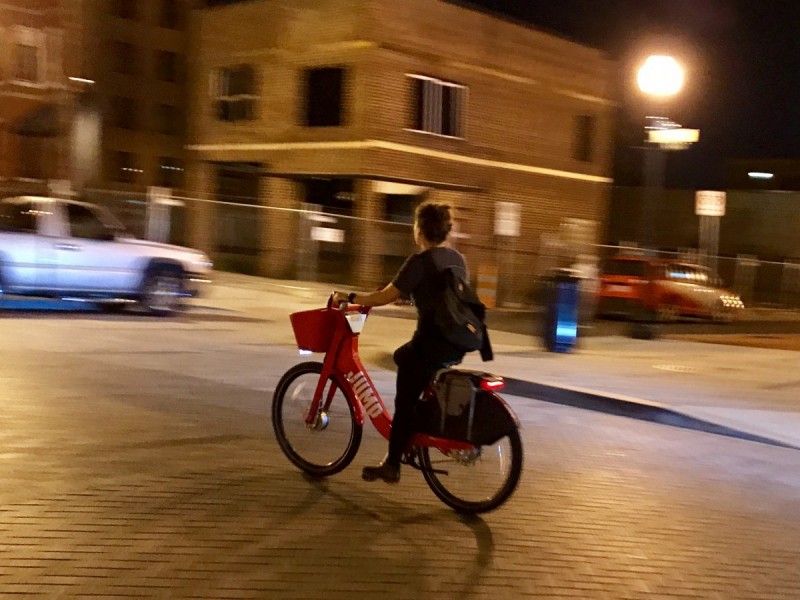More dockless e-bikeshares are rolling out across the US. What impact could they have on cities?

JUMP electric bike in DC. Image by Joe Flood used with permission.
E-bikes of all kinds are rolling out in cities in the warmer regions of the US, some as part of an existing dockless bikeshare that is adding an electric option. What impact will the increasing numbers and popularity of these dockless, electric-assist cycles have on cities, especially DC?
Dockless electric bikeshare company JUMP launched widely in the District to rave reviews. Now other dockless bikeshare companies, including Spin, LimeBike, and GenZe, are debuting their own e-bike prototypes around the country.
If they are as beloved elsewhere as they are in DC and draw new cyclists, they could end up having a real influence on local bike laws and infrastructure.
Spin's e-bike. Image by Spin used with permission.
Here’s where you can now ride dockless e-bikeshare
Spin is also adding an electric bike to its fleet that is capable of traveling up to 50 miles on a single charge. They will first be available in the markets with the company’s earliest partners, including Miami and University of California San Diego, and cost $1.50 for each 15 minutes.
Motivate, the company behind the San Francisco Bay Area’s bikeshare, is launching a pilot program adding 250 GenZe electric bicycles to its San Francisco fleet. The sleek black bikes will be available beginning in April 2018.
Lastly, Limebike is debuting its dockless e-bikes in Seattle, Miami, Scottsdale, Southern California, and the greater San Francisco Bay area. It features a 62-mile range and costs $1 to unlock and $1 to ride every 10 minutes after that.
All of the bikes top out at speeds of roughly 15 miles per hour, though GenZe can clock up to 18 miles per hour and JUMP can go up to 20. Jump is the sole electric bike operating in the District currently. While there have been notable pushbacks to dockless bikes overall, Jump's e-assist capacity has found favor.
Limebike's e-bike, or Lime-E. Image by Limebike used with permission.
E-bikes could influence local laws and infrastructure
GenZe CEO Vish Palekar said in a press release, “Our e-Bikes can go anywhere a conventional bicycle can go, including shared lanes and cycling paths.”
While this is physically true in DC, it isn’t true legally. E-bikes are technically outlawed on trails in Washington, but if e-bikes continue to boom in popularity and availability, this may put pressure on local authorities to revisit these rules.
“Electric bicycles, or e-bikes, have been shown to break down barriers to biking including hills, disabilities, age, and distance,” Spin’s chief technology officer, Zaizhuang Cheng, said in a statement.
Similarly, LimeBike’s press release noted, “You could ride the five miles separating Gas Works Park from downtown Seattle, covering over 320 ft of elevation gain, all for around $3 — and all without breaking a sweat!”
GenZe's e-bike. Image by GenZe used with permission.
It’s not just PR reps saying this. Since e-bikes have the ability to rocket cyclists up hills and to propel them along more quickly and with less effort, some people think they might end up partially displacing ride hailing. When traffic is heavy, they are also more efficient in clogged city centers than sitting in a vehicle.
“Thinking of JUMP as bikeshare misses what it truly is and what it's competing with,” David Alpert wrote in his review. “The places we'd go on a JUMP bike…look a lot more like “where we'd Uber to” than “where we'd bike.”’
In general, adding dockless bikes, whether electric or not, seems to be expanding the amount and types of people interested in cycling. In DC, dockless bikes seem to be drawing more young black riders than the docked bikeshare. E-bikes provide a new option for those who don’t have the physical ability (or desire) to pedal through a hilly commute.
If e-bikes (and dockless and other bike shares more generally) continue to be popular and get more people regularly cycling, this could help put pressure on cities to expand their bike infrastructure and otherwise become more cyclist-friendly.
